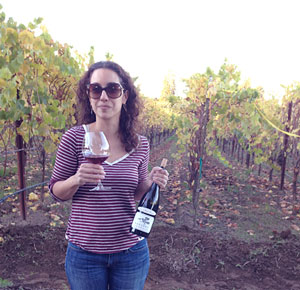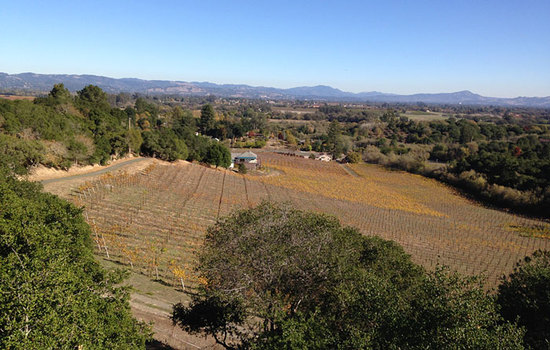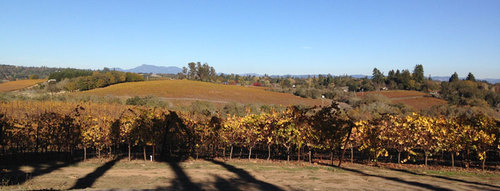| « Previous | News | Next » |
November 30, 2015
Behind the Vines: Russian River Valley
Davis Family Vineyards and Banshee Wines
Written by Kate Soto
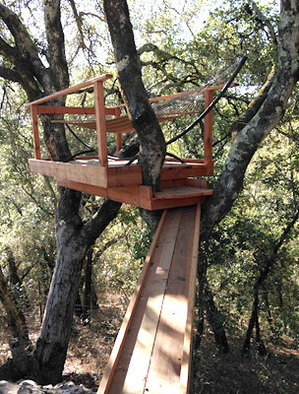 On a narrow two-lane highway called Eastside, I followed Guy Davis. We wound through vineyards bathed in golden leaves, through hillsides and oak trees and even some ramshackle red barns. We pulled over to the side of the road to help two cyclists find their way. Davis, himself a cyclist, a local, and an infectiously friendly soul, was probably the perfect person these folks could have stopped. Under the bright noon sun, we made our way to his Soul Patch Vineyard (pictured above): 15 acres of old-vine Zinfandel, Pinot Noir, Chardonnay, Syrah, and Viognier comprise a curved basin that abuts his own house. The house itself is beautiful—open floor plan, towering windows, and a hammock on its own perch in an oak tree, overlooking forests and vineyards for miles. The phrase “living the life” kept coming to mind.
On a narrow two-lane highway called Eastside, I followed Guy Davis. We wound through vineyards bathed in golden leaves, through hillsides and oak trees and even some ramshackle red barns. We pulled over to the side of the road to help two cyclists find their way. Davis, himself a cyclist, a local, and an infectiously friendly soul, was probably the perfect person these folks could have stopped. Under the bright noon sun, we made our way to his Soul Patch Vineyard (pictured above): 15 acres of old-vine Zinfandel, Pinot Noir, Chardonnay, Syrah, and Viognier comprise a curved basin that abuts his own house. The house itself is beautiful—open floor plan, towering windows, and a hammock on its own perch in an oak tree, overlooking forests and vineyards for miles. The phrase “living the life” kept coming to mind.
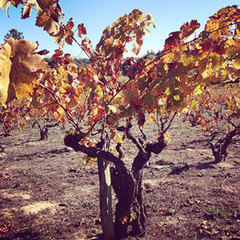 The grapes were gone after the recent harvest, and autumn colors rippled over leaves that would soon be falling off. Davis found this property at a good price when the bank was desperate to unload it—the house had been badly mangled (think sledgehammer) by meth heads when they were forced to vacate. The vineyards had been completely neglected. But miraculously, when Davis and his son were clearing it out, they discovered some gnarly Zinfandel vines that had just barely made it. Davis started nursing these “grumpy old men” (planted in 1896!) back to life. No small amount of work and 20 years later, many of these vines are thriving, producing surprising—and stunning—Zins that are reminiscent of a Sangiovese: bright acid, bright red fruits, and a buoyancy that is anything but the jammy California Zin of yore.
The grapes were gone after the recent harvest, and autumn colors rippled over leaves that would soon be falling off. Davis found this property at a good price when the bank was desperate to unload it—the house had been badly mangled (think sledgehammer) by meth heads when they were forced to vacate. The vineyards had been completely neglected. But miraculously, when Davis and his son were clearing it out, they discovered some gnarly Zinfandel vines that had just barely made it. Davis started nursing these “grumpy old men” (planted in 1896!) back to life. No small amount of work and 20 years later, many of these vines are thriving, producing surprising—and stunning—Zins that are reminiscent of a Sangiovese: bright acid, bright red fruits, and a buoyancy that is anything but the jammy California Zin of yore.
As the owner and winemaker at Davis Family Vineyards, Guy farms this all organically, harvests by hand, and works with a small team of which he and his two sons, Cole (“Cellarmaster”) and Cooper (“Assistant Everything”), make up about half. In addition to their estate vineyard, they source from about a half dozen other vineyards, paying extremely close attention to each particular microregion within the Valley. Guy is part of a group called the Neighborhood Initiative, focused on understanding the various undesignated subzones in the Valley. Luckily, Pinot Noir, perhaps the world’s most notorious grape for demonstrating terroir nuance, thrives here, with over 4,500 acres planted. Davis’s Pinots, though hard to categorize generally since they each are rooted in their subzones, tend toward the taut and focused, with peppery spice, deeply layered fruits, silky tannins—certainly not the jammy Pinots of which RRV can sometimes be accused.
As many a local put it to me, this is Burgundy to Napa’s Bordeaux. It’s 16,000 acres of small farms and small farmers, often with more ambition toward quality than scale (Davis told me it’d be impossible to have the kind of control he has now if his operation were to grow any bigger. He just doesn’t want to). In many ways, it feels like you’re in a company town. Brandon Holliday from Banshee Wines was my host with the most for the second half of the day. Raised in Healdsburg, he seemed to know everyone in town—or maybe just everyone at the Iron Horse tasting area. We started our journey there, on a beautiful crest in Sebastopol, and everyone I met was in some way connected to the wine industry—and not in a name-dropping-competitive way, but in a passionate-about-great-juice way.
 I felt like Little Orphan Annie, “I think I’m gonna like it here.”
I felt like Little Orphan Annie, “I think I’m gonna like it here.”
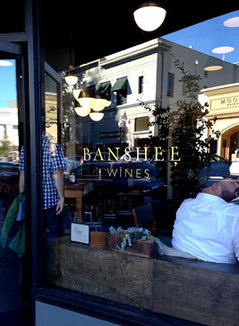 Not least because Brandon himself is a musician, Banshee Wines has a rock-n-roll feel. Their tasting room in downtown Healdsburg is modern and loungey, with events and DJs and vinyl records. The project was started by three buddies, Noah Dorrance, Baron Ziegler, and Steve Graf, who followed separate vinous paths then reconvened in San Francisco and pooled their money to start Banshee. They focus their winemaking on extreme coastal sites in Sonoma, and make killer Pinot and Chardonnay in friendly price ranges. Their wines are unpretentious and infinitely drinkable—lower alcohol and food loving, with a tendency toward the pretty, delicate, and expressive. And when not making delicious juice, they’re pouring it at music events like their Bansheefest in 2014.
Not least because Brandon himself is a musician, Banshee Wines has a rock-n-roll feel. Their tasting room in downtown Healdsburg is modern and loungey, with events and DJs and vinyl records. The project was started by three buddies, Noah Dorrance, Baron Ziegler, and Steve Graf, who followed separate vinous paths then reconvened in San Francisco and pooled their money to start Banshee. They focus their winemaking on extreme coastal sites in Sonoma, and make killer Pinot and Chardonnay in friendly price ranges. Their wines are unpretentious and infinitely drinkable—lower alcohol and food loving, with a tendency toward the pretty, delicate, and expressive. And when not making delicious juice, they’re pouring it at music events like their Bansheefest in 2014.
Russian River Valley has long been established as one of the best places in California—and on the planet—to grow Pinot. Being there in person helps you to feel the reality of this in your bones. I spent the day among sun-drenched vineyards, so I forgot my sweater (it was 70 degrees that day!) when visiting the Tina Marie Vineyard (no relation to this Teena Marie) during sunset. I was thoroughly reminded of that old “diurnal shift” that winemakers like to point out with pride. It’s exactly this yin-yang of golden California sun and chilly coastal fog that makes it a haven for Pinot Noir.
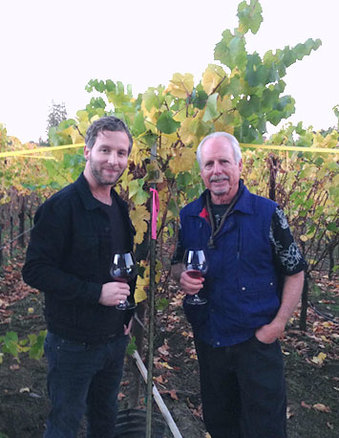 Brandon and I met up with Ron Black, co-owner of the vineyard (Stephen Bessone is the other owner, and it’s his mom who is the vineyard’s namesake). They bought the property and planted 11 acres of Pinot in 1999, and have since spent many a harvest night there in a trailer located 10 feet from the vines. The 1,700 vines are tightly spaced, and everything here is done by hand. Uniquely situated on the border of the Sonoma Coast and Green Valley regions, it enjoys a litany of Pinot-friendly environmental factors: It gets both the heat from the river and the cooling influence of Bodega Bay only 18 miles away. Coastal fog creeps in at night and helps the grapes from getting too ripe too fast. It’s at one of the higher elevations in Green Valley. In addition to the fertile Goldridge sandy loam soil in Russian River, it also has moisture-retaining clay, so it needs very little irrigation. And the grapes thrive: producing bright and transparent wines with notes of cranberry, currant, black tea, and violet pastille.
Brandon and I met up with Ron Black, co-owner of the vineyard (Stephen Bessone is the other owner, and it’s his mom who is the vineyard’s namesake). They bought the property and planted 11 acres of Pinot in 1999, and have since spent many a harvest night there in a trailer located 10 feet from the vines. The 1,700 vines are tightly spaced, and everything here is done by hand. Uniquely situated on the border of the Sonoma Coast and Green Valley regions, it enjoys a litany of Pinot-friendly environmental factors: It gets both the heat from the river and the cooling influence of Bodega Bay only 18 miles away. Coastal fog creeps in at night and helps the grapes from getting too ripe too fast. It’s at one of the higher elevations in Green Valley. In addition to the fertile Goldridge sandy loam soil in Russian River, it also has moisture-retaining clay, so it needs very little irrigation. And the grapes thrive: producing bright and transparent wines with notes of cranberry, currant, black tea, and violet pastille.
Amazing things happen in the 150 square miles of Russian River Valley. Good people come together to farm and drink and enjoy good wine. But here’s the news: even better things are to come. Guy Davis said that 2015 is one of the best vintages he’s ever seen. The harvest came in early and light—down by almost half—but made up for the quantity with quality. Thanks to the ongoing drought, the berries were tiny, but, since they had the same number of aromatic compounds, the wines display layers of concentration and flavor. The tannins are friendly and ripe and the acidity is mouthwatering. 2015 exceeded all his expectations, and an inspired Guy said, “I’m grateful to have this piece of the world to create this Pinot.” And, friends, I’m grateful to drink it.
